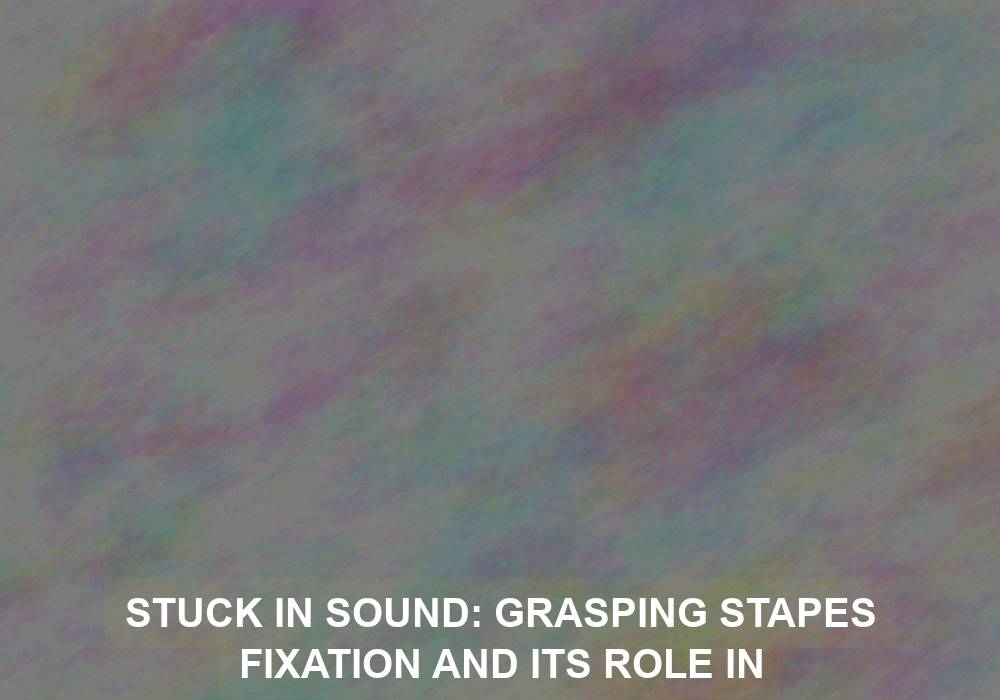Otosclerosis is a common hearing disorder that affects the middle ear, particularly the tiny bone called the stapes. This condition can cause significant hearing loss and impact the quality of life for those affected. Understanding the mechanism behind otosclerosis, specifically stapes fixation, is crucial in developing effective treatments and interventions. In this article, we will delve into the intricate details of stapes fixation and its role in otosclerosis.
What is Otosclerosis?
Otosclerosis is a progressive condition characterized by abnormal bone growth in the middle ear. This abnormal growth affects the mobility of the ossicles, the three tiny bones responsible for transmitting sound from the outer ear to the inner ear. The ossicles consist of the malleus (hammer), incus (anvil), and stapes (stirrup).
The stapes, being the smallest bone in the human body, plays a vital role in conducting sound vibrations to the cochlea, the spiral-shaped structure responsible for converting sound into electrical signals. However, in otosclerosis, the stapes becomes immobilized or fixed due to the abnormal bone growth, hindering its ability to transmit sound efficiently.
Otosclerosis is thought to have a genetic component, as it often runs in families. Hormonal factors, such as pregnancy and hormonal imbalances, have also been linked to the development or worsening of otosclerosis. Additionally, viral infections, such as measles, have been associated with the onset of otosclerosis. These factors contribute to the abnormal bone growth that leads to stapes fixation.
Grasping Stapes Fixation
Stapes fixation refers to the abnormal fixation of the stapes bone, resulting in its immobility. It is one of the hallmark features of otosclerosis. The exact cause of otosclerosis is still not fully understood, but genetics, hormonal factors, and viral infections have been identified as potential contributors to the condition.
When otosclerosis occurs, abnormal bone tissue replaces the healthy bone structure around the stapes. This bone tissue, known as spongy or cancellous bone, is less dense and more prone to complications. As the spongy bone replaces the normal bone, the stapes becomes stiff and loses its ability to vibrate freely in response to sound waves.
The fixation of the stapes disrupts the normal transmission of sound vibrations from the outer ear to the inner ear. Normally, the stapes acts as a bridge, connecting the eardrum to the cochlea. When sound waves enter the ear canal, they cause the eardrum to vibrate. These vibrations are then transferred to the ossicles, including the stapes, which amplifies the sound and sends it to the cochlea. However, in otosclerosis, the fixed stapes cannot vibrate properly, leading to a reduction in sound transmission.
The Impact of Stapes Fixation on Hearing
Stapes fixation significantly affects hearing by disrupting the transmission of sound vibrations to the cochlea. The immobile stapes fails to adequately amplify sound, leading to a conductive hearing loss. Conductive hearing loss occurs when sound waves cannot efficiently pass through the outer and middle ear to reach the inner ear.
Individuals with otosclerosis often experience progressive hearing loss, difficulty understanding speech, tinnitus (ringing in the ears), and a feeling of fullness in the affected ear. These symptoms can have a profound impact on daily activities, communication, and overall quality of life.
In addition to the physical impact on hearing, otosclerosis can also have emotional and psychological effects. The gradual loss of hearing can lead to social isolation, frustration, and a decreased sense of well-being. It is important for individuals with otosclerosis to seek appropriate treatment to address these challenges and improve their overall quality of life.
Diagnosis and Treatment Options
Diagnosing otosclerosis typically involves a combination of medical history review, physical examination, and audiological tests. Audiological tests, such as pure-tone audiometry and tympanometry, can help evaluate the extent of hearing loss and determine if stapes fixation is the underlying cause.
Various treatment options are available for individuals with otosclerosis, depending on the severity of symptoms and the impact on daily life. These options include:
-
Hearing aids: For individuals with mild to moderate hearing loss, hearing aids can help amplify sound and improve hearing abilities. Hearing aids work by capturing sound waves and converting them into electrical signals that are then amplified and delivered to the ear. However, hearing aids may not be sufficient in cases with significant stapes fixation.
-
Stapedectomy: Stapedectomy is a surgical procedure aimed at restoring hearing by replacing the immobilized stapes with a prosthetic device. During the procedure, the surgeon removes the fixed stapes and inserts a tiny piston-like implant to simulate its function. Stapedectomy is highly successful in improving hearing for the majority of patients. It is considered a more invasive procedure compared to stapedotomy.
-
Stapedotomy: Similar to stapedectomy, stapedotomy is a surgical procedure that involves creating a small hole in the fixed stapes. Through this hole, a prosthesis is inserted to bypass the immobile stapes and restore sound transmission. Stapedotomy is considered less invasive than stapedectomy and can be a suitable option for certain patients. It offers comparable hearing improvement with a shorter recovery period.
It is important to consult with an otolaryngologist or an ear, nose, and throat specialist to determine the most appropriate treatment plan based on individual circumstances. They can provide a thorough evaluation, discuss the potential risks and benefits of each treatment option, and guide patients in making informed decisions.
Conclusion
Stapes fixation plays a crucial role in otosclerosis, a condition characterized by abnormal bone growth in the middle ear. The fixation of the stapes hampers the transmission of sound vibrations to the inner ear, resulting in conductive hearing loss. However, with advancements in medical interventions such as stapedectomy and stapedotomy, individuals with otosclerosis can regain their hearing abilities and improve their quality of life. Early diagnosis and prompt intervention are key in managing otosclerosis effectively. If you suspect a hearing problem, it is important to seek medical attention and explore the available treatment options tailored to your specific needs.
